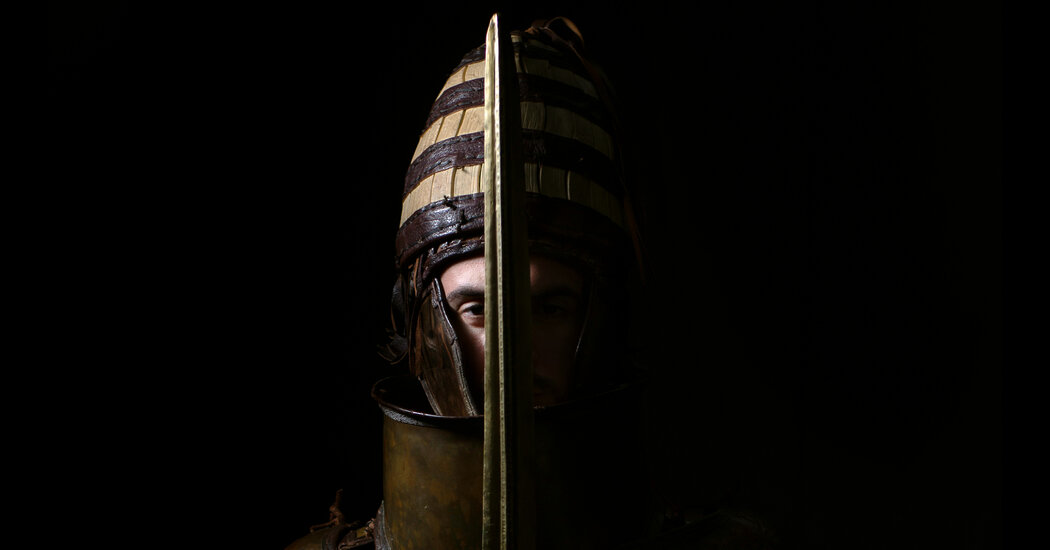
One by one, Greek soldiers, bellies full from a breakfast of red wine and dry bread, armed and clad themselves in a bulky, buglike suit of armor as they prepared for battle.
They aimed their spears at wooden targets, and their chariot was connected to a treadmill motor, but for 11 hours, these elite soldiers from the Hellenic Armed Forces pretended to fight as if it was the 15th century B.C.
They had been recruited for a study to determine if the Dendra panoply, a suit of armor from 3,500 years ago considered to be one of the oldest known from the Bronze Age in Europe, could be worn in battle. Or if it was only ceremonial, as some scholars have previously argued.
The soldiers wore a replica of the suit, and scientists tracked their blood-glucose levels, heart rates and other physiological measures, finding that the men’s bodies could handle the strain of the armor, according to a paper published in the journal PLOS One on May 22.
Andreas Flouris, the lead author of the paper and the director of the FAME Lab at the University of Thessaly in Volos, Greece, where the battles took place, said that the simulated combat, as well as other research components, showed that the armor would have been “a very advanced piece of military technology” at the time.
“If you’re carrying a piece of wood or a stone or maybe something with a bit of bronze in the front, like a spear, somebody wearing this armor looks like a giant robot in front of you,” said Dr. Flouris, a professor of physiology at the University of Thessaly.
An Ancient Guide to Battle
There are no historical accounts of how the Dendra armor was used, according to the research, so the soldiers’ combat day was based on an analysis of “The Iliad,” Homer’s account of the Trojan War.
The paper’s authors acknowledged that “The Iliad” does not provide a precise account of late Bronze Age warfare, which took place about 500 years before Homer wrote the epic poem, but said that it was “a rational starting point” for the research.
In the combat study, the soldiers fought on foot and on chariot, using replica weapons including a spear with blunted edges and a point, and spent a lot of time walking and chariot riding. They also followed a meal plan created by the researchers, which included a breakfast of mostly dry bread, goat cheese, green olives and red wine.
They could not wear the Dendra armor, which is dated to around 1450 B.C. Instead, the soldiers donned a replica made of copper, the closest alloy to the original bronze that was available, the study said. The replica was made in 1984 by students and staff in the metalworking department at the now-closed Bournville College of Art in Birmingham, England.
Wanted: Soldiers the Size of Ancient Greeks
Researchers sought out marines who had similar body proportions to the elite soldiers of the period for the simulated battles, which took place in 2019.
The 13 unpaid volunteers they recruited were all men in their 20s and 30s and were an average of about 5 feet 7 inches tall and 163 pounds.
The soldiers received two days of training before combat day, which began with a 5:30 a.m. wake-up. Their physiological data were monitored throughout the day, and the study found that they had been able to fight in the armor, which weighs 23.3 kilograms (or more than 51 pounds).
The exercise took its toll: The soldiers showed a high level of fatigue, sore upper bodies from the weight of the metal and foot pain from walking, running, riding a chariot and fighting barefoot, according to the study.
Dr. Flouris said the findings provided a clue as to how the Mycenaean civilization was able to rule over a large part of the eastern Mediterranean before it collapsed at the end of the Bronze Age. “This study provides important support to the hypothesis many have put forth that military technology had a lot to do with that,” he said.
21st-Century Limits on Bronze Age Combat
Dr. Flouris said that the study used conservative measurements because of the limits of replicating millenniums-old combat. For instance, the soldiers in the study had not been trained to fight in those conditions at the same level as ancient elite soldiers would have been, and they were engaging in warfare for science, not as matter of life or death.
To address some of these limits, the researchers did math simulations to test what would have happened to a soldier wearing the Dendra armor if, for instance, their heart rate reached 200 beats per minute instead of 140.
Lee L. Brice, a history professor at Western Illinois University in Macomb, Ill., who was not involved with the research, said that he teaches students about the Dendra armor. He had thought that the armor could be used in chariot warfare, but that it would have been too inflexible for combat. “They’ve proven that old idea is wrong,” he said.
Because the Dendra armor would have been worn only by the Mycenaeans’ top warriors, the research does not reveal much about ancient soldiers more widely, Dr. Brice said.
“At best, we know how one very elite person could very capably have fought in battle wearing this,” said Owen Rees, a lecturer in applied humanities at Birmingham Newman University in Birmingham. He also was not involved with the research.
Dr. Rees said that historians tried not to use “The Iliad” to understand Mycenaean warfare, but that the paper still succeeded by challenging assumptions about the Dendra armor.
“It’s easy to see this as a weird novelty,” Dr. Rees said. “But this kind of research has a place.”
The post Have Wine for Breakfast, Put On a 51-Pound Suit and Get to the Battlefield appeared first on New York Times.